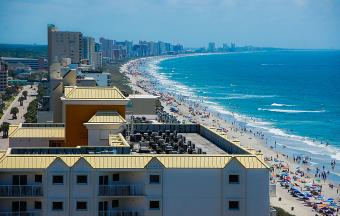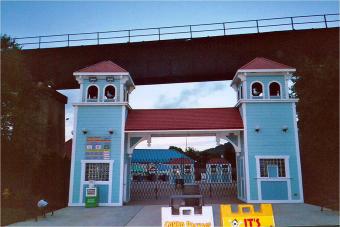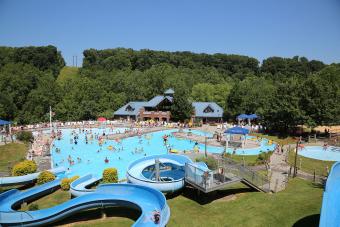
Theme park maps are more than just useful tools for lost park guests - they are a great planning resource, a valuable souvenir, and a nostalgic collectible.
Why You Need Maps
The obvious reason to need an amusement park map is to avoid getting lost among the wild lights and meandering paths of a park's layout. A map can actually help guests in a number of ways, however, such as allowing them to plot the best route to major attractions and save time getting from one ride to the next. Maps detail where to find essential services such as restrooms, first aid stations, cash machines, and lost and found offices. Some guests may use maps as checklists for their favorite rides and attractions, and others may keep theme park maps as souvenirs of their theme park getaway. No matter how a map is used, it can reduce guests' stress by ensuring they can find their way around the park with minimal effort, which will help them make the most of their visit.
Park Map Characteristics
All theme and amusement park maps share certain characteristics, including:
- Easy to follow directions and layouts
- Icons to indicate guest services and other necessities
- Proper ride, restaurant, and gift shop names
- Important park information such as parent ride policies, operating hours, or visitor tips
- Entertainment options and show times
While not every map will have every piece of information a guest will need to make the most of their visit, most parks offer a range of map styles to help guests plan their stay effectively.
Types of Maps
There are several types of park maps available at most parks. Smaller parks may only offer basic maps, but larger parks typically have several specialized maps for interested visitors.
- Brochures: A basic brochure map folds out to show the park's layout and includes visitor information, tips, and other details as well as the basic map.
- You Are Here: These large, freestanding maps are often scattered around the busiest areas of a park to help guests orient themselves.
- Souvenirs: More colorful, larger maps may be offered as souvenirs. Poster-size Cedar Point park maps are an example of souvenir maps.
- Specialty: Small maps may be offered for specialized purposes, such as showing all the park's restaurants or where different shows are performed.
- Resort: Large theme park complexes may offer resort maps that show the park in relation to nearby hotels, other parks, and additional attractions. A large map of Disney World, for example, will show all the major parks, Disney resort hotels, Disney golf courses, and other related attractions.
Where to Find Theme Park Maps
Park maps aren't difficult to find, if prospective guests know where to look.
- Outside the Park: Brochure maps are typically available for free at a number of locations, including local hotels, tourist centers, and nearby stores. For larger parks, resort maps are often available at these locations as well.

- At the Park: Brochure and specialty maps are frequently found at park admission gates, guest service centers, on site management offices, and in gift shops. Souvenir maps can be purchased from gift shops and kiosk stands. Large "you are here" maps can be found near entrances and busy park intersections.
- Online: Most theme parks' websites have online maps available to view, download, and print. Some parks also offer interactive online maps with virtual tours of the park. The website ThemeParkBrochures.net also offers a range of scanned maps from dozens of parks, including outdated and collectible maps, and other park fan sites may also have maps available online.
- Travel Agencies: Most travel agencies have park maps on hand for local or regional theme parks, as well as mega park resorts such as Disney World or Disneyland theme park.
- By Mail: Guests who want to have brochures and maps before they travel to a new theme park may be able to request maps by mail by contacting the parks directly. Some parks mail seasonal information regularly, or contacting the park's customer service number can result in a free map by mail.
Collecting Maps
Theme park maps are popular collectibles for park enthusiasts. Because parks grow and change rapidly to entice new visitors, a collection of maps can show the park's history and growth in a fun, visual way. The most collectible park maps are…
- Old: Older maps may show a different style of drawing or illustration, and they either lack key modern attractions or highlight attractions that have been removed that show the park's history.
- In Good Condition: Handling a map, including opening and closing the folds frequently, can cause tears and wear that will depreciate the map's value.
- Unique: Very rare maps may show errors in spelling that create instant value for collectors. Other rare maps may be from closed or abandoned amusement parks.
It's easy to collect park maps and brochures while visiting theme parks, or serious collectors can browse online auction sites and antique stores for rare and valuable maps.
Effective Map Use Tips
To make the most of amusement park maps:
- Pick up several different types of maps for a thorough overview of the park and all it has to offer, as well as to be sure everyone has a map to use.
- Browse maps before visiting the park to familiarize yourself with the park's layout, major routes, and potential problems.
- Bring a pen or marker to use the map as a checklist so you don't miss any of the fun shows, rides, or other attractions.
Theme park maps are great tools for a fun park visit, and they can be colorful souvenirs and collectibles as well, letting every guest find their way to a good time.







